[English] 日本語
 Yorodumi
Yorodumi- PDB-2xfb: CHIKUNGUNYA E1 E2 ENVELOPE GLYCOPROTEINS FITTED IN SINDBIS VIRUS ... -
+ Open data
Open data
- Basic information
Basic information
| Entry | Database: PDB / ID: 2xfb | ||||||
|---|---|---|---|---|---|---|---|
| Title | CHIKUNGUNYA E1 E2 ENVELOPE GLYCOPROTEINS FITTED IN SINDBIS VIRUS cryo- EM MAP | ||||||
 Components Components |
| ||||||
 Keywords Keywords | VIRUS / ALPHAVIRUS / RECEPTOR BINDING / MEMBRANE FUSION / ICOSAHEDRAL ENVELOPED VIRUS | ||||||
| Function / homology |  Function and homology information Function and homology informationT=4 icosahedral viral capsid / host cell cytoplasm / serine-type endopeptidase activity / fusion of virus membrane with host endosome membrane / symbiont entry into host cell / virion attachment to host cell / host cell nucleus / host cell plasma membrane / virion membrane / structural molecule activity ...T=4 icosahedral viral capsid / host cell cytoplasm / serine-type endopeptidase activity / fusion of virus membrane with host endosome membrane / symbiont entry into host cell / virion attachment to host cell / host cell nucleus / host cell plasma membrane / virion membrane / structural molecule activity / proteolysis / RNA binding / identical protein binding / membrane Similarity search - Function | ||||||
| Biological species |   CHIKUNGUNYA VIRUS CHIKUNGUNYA VIRUS | ||||||
| Method | ELECTRON MICROSCOPY / single particle reconstruction / cryo EM / Resolution: 9 Å | ||||||
 Authors Authors | Voss, J.E. / Vaney, M.C. / Duquerroy, S. / Rey, F.A. | ||||||
 Citation Citation |  Journal: Nature / Year: 2010 Journal: Nature / Year: 2010Title: Glycoprotein organization of Chikungunya virus particles revealed by X-ray crystallography. Authors: James E Voss / Marie-Christine Vaney / Stéphane Duquerroy / Clemens Vonrhein / Christine Girard-Blanc / Elodie Crublet / Andrew Thompson / Gérard Bricogne / Félix A Rey /  Abstract: Chikungunya virus (CHIKV) is an emerging mosquito-borne alphavirus that has caused widespread outbreaks of debilitating human disease in the past five years. CHIKV invasion of susceptible cells is ...Chikungunya virus (CHIKV) is an emerging mosquito-borne alphavirus that has caused widespread outbreaks of debilitating human disease in the past five years. CHIKV invasion of susceptible cells is mediated by two viral glycoproteins, E1 and E2, which carry the main antigenic determinants and form an icosahedral shell at the virion surface. Glycoprotein E2, derived from furin cleavage of the p62 precursor into E3 and E2, is responsible for receptor binding, and E1 for membrane fusion. In the context of a concerted multidisciplinary effort to understand the biology of CHIKV, here we report the crystal structures of the precursor p62-E1 heterodimer and of the mature E3-E2-E1 glycoprotein complexes. The resulting atomic models allow the synthesis of a wealth of genetic, biochemical, immunological and electron microscopy data accumulated over the years on alphaviruses in general. This combination yields a detailed picture of the functional architecture of the 25 MDa alphavirus surface glycoprotein shell. Together with the accompanying report on the structure of the Sindbis virus E2-E1 heterodimer at acidic pH (ref. 3), this work also provides new insight into the acid-triggered conformational change on the virus particle and its inbuilt inhibition mechanism in the immature complex. #1:  Journal: Structure / Year: 2006 Journal: Structure / Year: 2006Title: Mapping the structure and function of the E1 and E2 glycoproteins in alphaviruses. Authors: Suchetana Mukhopadhyay / Wei Zhang / Stefan Gabler / Paul R Chipman / Ellen G Strauss / James H Strauss / Timothy S Baker / Richard J Kuhn / Michael G Rossmann /  Abstract: The 9 A resolution cryo-electron microscopy map of Sindbis virus presented here provides structural information on the polypeptide topology of the E2 protein, on the interactions between the E1 and ...The 9 A resolution cryo-electron microscopy map of Sindbis virus presented here provides structural information on the polypeptide topology of the E2 protein, on the interactions between the E1 and E2 glycoproteins in the formation of a heterodimer, on the difference in conformation of the two types of trimeric spikes, on the interaction between the transmembrane helices of the E1 and E2 proteins, and on the conformational changes that occur when fusing with a host cell. The positions of various markers on the E2 protein established the approximate topology of the E2 structure. The largest conformational differences between the icosahedral surface spikes at icosahedral 3-fold and quasi-3-fold positions are associated with the monomers closest to the 5-fold axes. The long E2 monomers, containing the cell receptor recognition motif at their extremities, are shown to rotate by about 180 degrees and to move away from the center of the spikes during fusion. | ||||||
| History |
|
- Structure visualization
Structure visualization
| Movie |
 Movie viewer Movie viewer |
|---|---|
| Structure viewer | Molecule:  Molmil Molmil Jmol/JSmol Jmol/JSmol |
- Downloads & links
Downloads & links
- Download
Download
| PDBx/mmCIF format |  2xfb.cif.gz 2xfb.cif.gz | 553.1 KB | Display |  PDBx/mmCIF format PDBx/mmCIF format |
|---|---|---|---|---|
| PDB format |  pdb2xfb.ent.gz pdb2xfb.ent.gz | 454.8 KB | Display |  PDB format PDB format |
| PDBx/mmJSON format |  2xfb.json.gz 2xfb.json.gz | Tree view |  PDBx/mmJSON format PDBx/mmJSON format | |
| Others |  Other downloads Other downloads |
-Validation report
| Arichive directory |  https://data.pdbj.org/pub/pdb/validation_reports/xf/2xfb https://data.pdbj.org/pub/pdb/validation_reports/xf/2xfb ftp://data.pdbj.org/pub/pdb/validation_reports/xf/2xfb ftp://data.pdbj.org/pub/pdb/validation_reports/xf/2xfb | HTTPS FTP |
|---|
-Related structure data
| Related structure data |  1121M  2xfcC 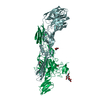 3n40C 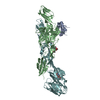 3n41C 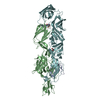 3n42C  3n43C 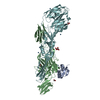 3n44C C: citing same article ( M: map data used to model this data |
|---|---|
| Similar structure data |
- Links
Links
- Assembly
Assembly
| Deposited unit | 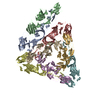
|
|---|---|
| 1 | x 60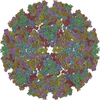
|
| 2 |
|
| 3 | x 5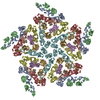
|
| 4 | x 6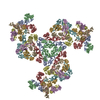
|
| 5 | 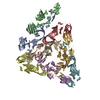
|
| Symmetry | Point symmetry: (Schoenflies symbol: I (icosahedral)) |
- Components
Components
| #1: Protein | Mass: 42554.148 Da / Num. of mol.: 4 / Fragment: ECTODOMAIN, RESIDUES 810-1248 Source method: isolated from a genetically manipulated source Source: (gene. exp.)   CHIKUNGUNYA VIRUS / Strain: 05-115 / Plasmid: PMRBIP/V5HISA / Production host: CHIKUNGUNYA VIRUS / Strain: 05-115 / Plasmid: PMRBIP/V5HISA / Production host:  #2: Protein | Mass: 37621.594 Da / Num. of mol.: 4 / Fragment: ECTODOMAIN, RESIDUES 326-748 Source method: isolated from a genetically manipulated source Source: (gene. exp.)   CHIKUNGUNYA VIRUS / Strain: 05-115 / Plasmid: PMRBIP/V5HISA / Production host: CHIKUNGUNYA VIRUS / Strain: 05-115 / Plasmid: PMRBIP/V5HISA / Production host:  Has protein modification | Y | |
|---|
-Experimental details
-Experiment
| Experiment | Method: ELECTRON MICROSCOPY |
|---|---|
| EM experiment | Aggregation state: PARTICLE / 3D reconstruction method: single particle reconstruction |
- Sample preparation
Sample preparation
| Component | Name: Sindbis virus / Type: VIRUS |
|---|---|
| Buffer solution | pH: 7.4 / Details: 20 mM Tris-Cl, 200 mM NaCl, 0.1 mM EDTA |
| Specimen | Embedding applied: NO / Shadowing applied: NO / Staining applied: NO / Vitrification applied: YES |
| Specimen support | Details: OTHER |
| Vitrification | Instrument: HOMEMADE PLUNGER / Cryogen name: ETHANE |
- Electron microscopy imaging
Electron microscopy imaging
| Microscopy | Model: FEI/PHILIPS CM200T / Date: Jun 21, 2000 |
|---|---|
| Electron gun | Electron source: OTHER / Accelerating voltage: 100 kV / Illumination mode: FLOOD BEAM |
| Electron lens | Mode: OTHER / Nominal magnification: 38000 X / Nominal defocus max: 2580 nm / Nominal defocus min: 1100 nm |
| Image recording | Electron dose: 18 e/Å2 / Film or detector model: KODAK SO-163 FILM |
| Radiation wavelength | Relative weight: 1 |
- Processing
Processing
| Symmetry | Point symmetry: I (icosahedral) | ||||||||||||
|---|---|---|---|---|---|---|---|---|---|---|---|---|---|
| 3D reconstruction | Resolution: 9 Å / Num. of particles: 7085 Details: THE COMPLETE PARTICLE IS GENERATED BY BIOMT MATRICES. THE FIT WAS GENERATED WITH URO IN SINDBIS CRYO-EM MAP EMDB-1121 USING PDB ENTRY 3N40. Symmetry type: POINT | ||||||||||||
| Atomic model building | PDB-ID: 3N40 Accession code: 3N40 / Source name: PDB / Type: experimental model | ||||||||||||
| Refinement | Highest resolution: 9 Å | ||||||||||||
| Refinement step | Cycle: LAST / Highest resolution: 9 Å
|
 Movie
Movie Controller
Controller


 UCSF Chimera
UCSF Chimera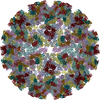
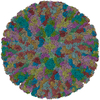
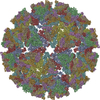

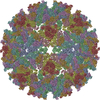
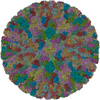
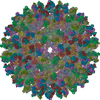
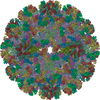

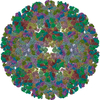
 PDBj
PDBj


